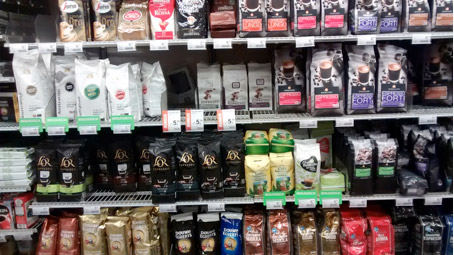How a Fair Trade alternative can ruin your brand
Relevant topics Archive, Strategy
Oh my god, you’re such a….! I don’t like being labeled. Unless it’s really cute. What I do like is labels that tell me whether I should or should not be buying a certain product. It’s the paradox of choice that paralyzes me when I’m ‘hangry’ after a long day’s work; standing in the supermarket, having to cook dinner which should be reasonably nice and preferably to our planet and the people living on it as well. But that’s me. However, these labels influence you too. As for the marketers: read below why it is important to know what you should or should not be doing with these labels.
The principle – how to change a social norm
The modern consumer market is changing – Fair Trade and organic products first launched as a small and exclusive niche. However they were able to grow and professionalize their businesses and enter the mainstream market. Today they’re competing with mainstream brands, but more importantly, these underdog brands managed to collaborate and join the big ones.
Imagine standing in front of a coffee shelf at your local supermarket; what you see are six different types of coffee from the same brand. For example: mocca, dark roast, regular, caffeine-free, mild and Fair Trade. You might not even (consciously) evaluate the different types, simply because you always choose dark roast. However, this (added) category of Fair Trade altered your evaluation – you were influenced, but how?
Reference point
When brands with organic and/or Fair Trade sustainability labels entered the market, they questioned the legitimacy of existing brands. By adding a new category that was previously irrelevant, they added a new type of diagnostic information and at the same time, set a new point of reference.
What does that mean? A recent study by Anagnostou, Ingenbleek and Van Trijp (2015) showed that organic/Fair Trade products satisfy a demand for socially responsible products for socially responsible consumers, and at the same time, they increase other consumers’ awareness and gradually change the ruling norms in society. Meaning, the Fair Trade category automatically implies that there is a different way of handling coffee and that other brands, or types of coffee, aren’t doing so.
Social coffee spilling
Using the theory of ‘legitimacy’ and ‘spillover effects’ the researchers investigated Fair Trade coffee in the Dutch market with participants who were non-sustainable shoppers (i.e., they exclusively used consumers of mainstream products). Legitimacy means as much as ‘a social norm’ (i.e., why consumers may change their perceptions of mainstream brands in the presence of sustainable alternatives). The spillover effect is the phenomenon in which any kind of communicated information influences beliefs about things that are not directly addressed.
The question is: Will selling organic Fair Trade alternatives as a competing brand with mainstream products lead to more sales? Also, will selling organic/Fair Trade alternatives under an existing brand, lead to a positive spillover for your brand?
Pro’s and con’s of adding sustainability labels
As the market consists of different parties a differentiation is made between them, with their own examples and implications regarding the adaptation of Fair Trade alternatives.
For sustainability labels – the answer is a double edged sword: Fair Trade/organic labels satisfy a demand of socially responsible consumers and at the same time, exert a subtle effect in the minds of the mainstream consumer, eroding the value of these mainstream brands and gradually challenging the legitimacy of the entire industry. In the long run: anticipate a change in industry and team up with retailers.
For retailers – you may benefit from including products with sustainability labels in your assortment in competitive situations. The reason for this is because after mainstream brands begin including sustainable products in their product line, consumers attribute rewards to the brand rather than retailers. As a retailer, be open minded and develop relationships with sustainability labels that want shelf space, making you the first to include new sustainable products in your assortment. A perfect example for retailers is WAAR. They’ve been able to open over six new stores in the last year, due to their clever concept. Focusing on sustainable and Fair Trade gifts (thus labels), they’re the first to present new product lines and they connect to consumers and allow them to feel good about their purchase.
For policy makers – when you want to achieve social objectives, support sustainability labels with investment subsidies, for example. Sustainability labels can change the market in the long run. Measure success by the presence and visibility of products, rather than market shares. As a policy maker, team up with sustainability labels and retailers, before brands include them in their product line.
For managers of brand companies – respond to sustainability labels by adopting them for your products is an effective strategy to increase your general and your corporate social responsibility (CSR) image. However, consumers will notice that not all of your products in your product line adhere to the uplifted sustainability norms. This will lead to negative spillovers to your mainstream products. Prevent this by being proactive and include social and sustainable options in your product line because you anticipate a change in social norms, while uplifting your product line.
As a sole sustainable brand, sell your product in the mainstream market. Your product will devaluate mainstream brands and enhance positive associations with your brand.
A delicious marketing example
There is a perfect and tasty example of a brand that entered the market as a sustainable alternative for mainstream products. They created a product category which solidified in the consumer brain. Who are they and what have they done? Tony’s Chocolonely was the first to enter the market as a Fair Trade chocolate maker, striving for 100% slave-free chocolate. At the start they had two flavors, now they produce over ten types of flavors, of which most are available at your local supermarket. Even better; Tony made mister A. Heijn an offer he couldn’t refuse enabling Heijn to sell an exclusive flavor. Why is Tony so effective? The different flavors, happy advertising and the physical appearance of the bar that underlines the message (congruence). They consolidate community building by annual voting rounds on temporary special flavors, and so on. Oh, and its chocolate, who doesn’t like chocolate? Tony’s indicate that an alternative is feasible: chocolate can be Fair Trade. So what is your next step?
 Supermarket coffee alternatives; with Fair Trade on discount.
Supermarket coffee alternatives; with Fair Trade on discount.
To read more about why consumers still shop unsustainable go here – article on changing the shopping behavior of unsustainable teens.
Further Reading
-
Boycott or buy from Primark? How to make adolescents care more about sustainability and how you can profit from it.
What is the real price of your clothing? Getting your hands on a six dollar t-shirt is inexpensive, but who actually pays for it?
Recently, a clothing factory in Bangladesh collapsed, instantly killing thousands of low-wage workers. The disaster caused public outcry; never again shall we buy from brands that expose people to such miserable circumstances. Yet in reality, Primark remains one of Europe’s most popular clothing outlets.

